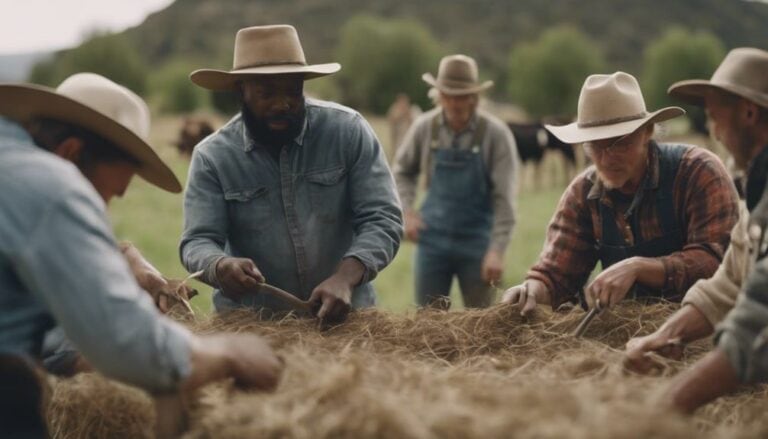In sustainable ranching, cultivating community ties through regenerative practices like promoting grazing techniques enhances support networks. Engaging stakeholders fosters resilience and commitment to environmental stewardship. Water conservation methods, such as rainwater harvesting, mitigate drought impacts and support ranch ecosystem health. Sharing knowledge on sustainable practices builds cohesion and biodiversity. Collective decision-making empowers stakeholders to shape policies for sustainable food production. Strengthening these ties guarantees long-term environmental and economic benefits.
Key Takeaways
- Facilitate knowledge sharing on regenerative grazing techniques.
- Empower stakeholders in decision-making for sustainable practices.
- Foster social cohesion through community engagement.
- Enhance resilience by supporting local ranching communities.
- Collaborate with partners for long-term conservation goals.
Promoting Regenerative Grazing Techniques
To effectively promote regenerative grazing techniques, it's essential to educate ranchers on the benefits of restoring degraded lands to native grasslands through sustainable practices. Regenerative grazing focuses on enhancing soil health, water retention, and biodiversity in grassland ecosystems. By adopting these practices, ranchers can play a vital role in carbon sequestration and combating the impacts of climate change. Partnerships with organizations provide valuable support regarding education and technical assistance for implementing regenerative grazing effectively.
Regenerative grazing is particularly important in regions with high biodiversity as it contributes to ecological resilience and fosters community sustainability. Educating ranchers about the positive impacts of regenerative grazing not only benefits the environment but also enhances the long-term viability of their operations. Through understanding the principles of sustainable practices, ranchers can make informed decisions that not only improve their land but also contribute to broader conservation efforts. By promoting regenerative grazing techniques, ranchers can actively participate in safeguarding the health of grassland ecosystems for future generations.
Engaging Local Stakeholders for Collaboration
Engage local stakeholders actively to foster collaboration in sustainable ranching initiatives. By involving local stakeholders in your sustainable ranching efforts, you can achieve shared goals that revolve around protecting grasslands, promoting regenerative grazing practices, and preserving biodiversity. This collaboration not only strengthens the community's support for sustainable ranching but also enhances ecological resilience and economic viability within the region. Through knowledge sharing, technical assistance, and educational opportunities provided by engaging with stakeholders, you can guarantee the adoption of sustainable ranching practices that benefit both the environment and the local economy. Working together with local stakeholders not only contributes to long-term conservation goals and biodiversity preservation but also aids in climate change adaptation within ranching communities.
- Foster a sense of community and belonging among local stakeholders.
- Create opportunities for shared learning and growth through collaborative efforts.
- Enhance the resilience of ranching communities in the face of climate change challenges.
Implementing Water Conservation Methods
Implementing water conservation methods on ranches is essential for reducing water usage and preserving natural resources. By adopting techniques like rainwater harvesting, drip irrigation, and rotational grazing, ranchers can enhance water efficiency and contribute to sustainable water management. These conservation practices play an important role in mitigating the impacts of drought and ensuring the long-term environmental sustainability of ranching operations.
Strategies such as soil moisture retention and water recycling not only help in conserving water but also promote the overall health of ranch ecosystems. Efficient water use is essential for maintaining resilience in the face of changing climatic conditions and decreasing water availability. Ranchers who prioritize sustainable water management contribute significantly to the conservation of natural resources while safeguarding the future of their operations.
Incorporating water conservation practices into ranching not only benefits the environment but also supports the economic viability of ranches by reducing water costs and increasing operational efficiency. By embracing these conservation methods, ranchers can play a key role in promoting environmental sustainability within their communities.
Fostering Social Cohesion Through Knowledge Sharing
Fostering social cohesion through knowledge sharing is key to building a strong and interconnected sustainable ranching community. When ranchers come together to share their expertise and experiences, it not only enhances individual practices but also benefits the entire community.
By exchanging information on regenerative grazing techniques, ranchers can improve sustainable land management practices, leading to healthier ecosystems and increased biodiversity. This shared knowledge on grassland conservation plays an essential role in preserving the environment and ensuring the long-term sustainability of ranching operations.
Additionally, collaborative efforts in sustainable ranching not only strengthen social bonds but also create a network of mutual support among community members. Education and training programs focused on sustainable practices further solidify these social connections, empowering ranchers to overcome challenges together and build resilience in the face of uncertainties.
Through knowledge sharing, sustainable ranching communities can thrive and make a positive impact on both the environment and society.
Enhancing Community Resilience Through Collective Decision-Making
Enhancing community resilience in sustainable ranching involves collaborative decision-making processes that empower stakeholders to shape policies and practices. By engaging community members in collective decision-making, sustainable agriculture initiatives can promote sustainable food production, support local farmers, and enhance local food systems. This approach guarantees that environmental stewardship is prioritized and that the diverse perspectives of community members are considered in shaping the future of ranching practices.
Collective decision-making in sustainable agriculture fosters shared values and positive changes that benefit both the environment and the local economy. Community input and collaboration play a vital role in addressing challenges, building capacity, and fostering a sense of ownership and pride in sustainable ranching initiatives. Through participation in decision-making processes, community members contribute to the long-term sustainability and success of food systems, leading to more inclusive and effective solutions.
Conclusion
As you continue to invest in sustainable ranching practices, remember that every step you take towards regenerative grazing has a significant impact on the environment.
Did you know that adopting regenerative grazing techniques can increase soil organic matter by up to 35% in just a few years?
By collaborating with local stakeholders, conserving water, sharing knowledge, and making collective decisions, you aren't only strengthening community ties but also building a more resilient and sustainable future for all.

